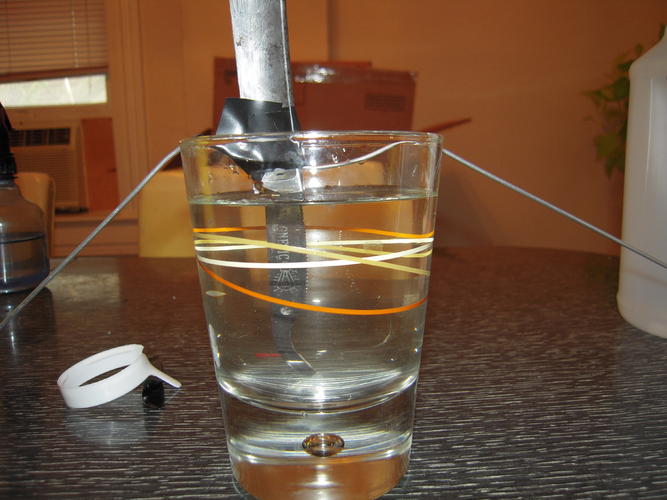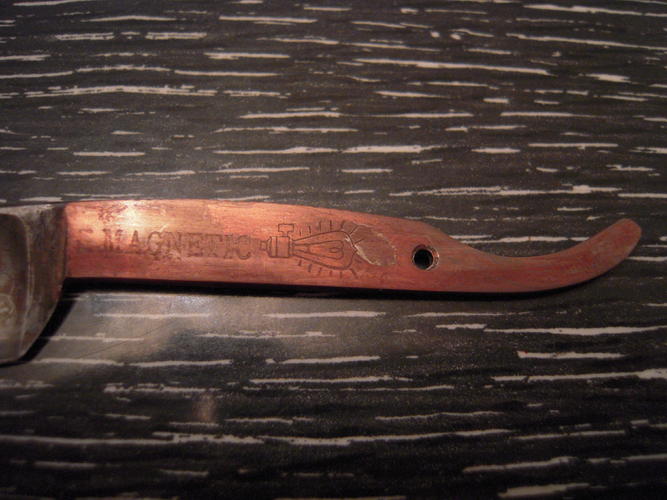Results 1 to 10 of 12
-
07-24-2011, 10:02 PM #1
 Kitchen chemistry- copper plating
Kitchen chemistry- copper plating
I ran across a neat little experiment on a chemistry blog: Home Chemistry: Penny chemistry - Verdigris and copper plating
and decided to give it a shot on a razor. Initially I was going to spend a lot of time cleaning and sanding, after an hour of hand sanding I decided it's clean enough (it wasn't) and proceeded with the experiment. First you need vinegar, I used distilled white, salt (NaCl), pennies, and your steel to be plated.
I put about a cup of vinegar in a glass and dumped in about 50 pennies. I picked a lot of dull oxidized pennies thinking the copper oxide would go into solution better than just copper. Let these sit in the vinegar for 5-10 minutes. After that time fish them out with an old spoon, and prep your metal to be plated. I suggest sanding the metal perfectly clean of tarnish/oxidation, and then using acetone or isopropyl alcohol to remove any grease/oil/contaminants from the metal. I used some aluminum rod I had laying around to fashion a holder:

After about two hours I ended up with this:

You can see in places where the plating is not even, I think this is because of my lackadaisical approach to prepping the steel. I ended up dumping 5 or so extra pennies in with the steel after about an hour, hoping to get some more copper into solution and push the equilibrium towards the plating-side. Also, don't let the metal touch the sides of the glass, or the pennies, because it will prevent that area from being plated. After all was said and done I rinsed with water, dried it off, rubbed extra copper off, and then put a coat of RenWax on to prevent oxidation (although that might look neat). Just thought I would share my experiment. I'm going to finish cleaning up the blade and put it back into it's scales. So we will see how durable it is.
edit: Some more thoughts, I coated everything I didn't want plated/oxidized in RenWax because I was afraid of vapors hitting the bare metal. I did end up with a little more oxidation above the vinegar line than I started with, but I think it should clean up.
-
07-24-2011, 10:38 PM #2Senior Member

- Join Date
- Dec 2010
- Location
- Brisbane, Qld, Australia
- Posts
- 378
Thanked: 94
Perhaps you should have cleaned the blade in molasses first.
http://straightrazorpalace.com/works...t-removal.html
Str8raz0r has shown me his experiments and apparently the correct mix is somewhere between 1:20 to 1:10 molasses to water ratio. Stu can give you the chemistry lesson about phenolic (?) acid.
-
07-24-2011, 11:19 PM #3

Very fun. I forgot about this experiment. We did it when we were kids.
-
07-24-2011, 11:39 PM #4< Banned User >

- Join Date
- Jun 2011
- Location
- miami,fl
- Posts
- 577
Thanked: 69
way cool!!!....
-
07-25-2011, 02:38 AM #5

Pauly: I actually thought about doing that, but I ended up not bothering with that and just went for the gold...er copper. I was getting pretty antsy to get this thing rolling. If it turns out to be durable I may strip the copper off and give it another shot. I think I could probably put the plated part back into fresh vinegar and it would strip it off. If I wanted to shove the equilibrium even further I could drop a couple steel nails in with it to suck up copper maybe. Might add iron back to the razor too though, I would have to think about that one.
The other idea I had was to push the reaction using an electric potential. I know the overall reduction potential of the rxn is about -0.1, but I'm not sure where the cathode and anode would go... it's been a long time since I've seen any electrochemistry.
edit: Okay, after having researched a little bit more, what I did was actually deposition, not plating. Essentially the copper, in the form of copper acetate, has effectively "landed" on the steel, not bound to it. In order to get it to bind permanently one would have to use a cyanide based solution, or a pyrophosphate copper solution. Sure, I could use both of those safely with my background, but I really don't want to. Maybe I will try a finish over the copper. CA, laquer, epoxy? I suppose we shall see.Last edited by adbuett; 07-25-2011 at 02:48 AM.
-
07-26-2011, 03:43 PM #6

I wonder if I used some spent brass shells instead of the copper pennies; any idea if it will work?
-
07-26-2011, 03:49 PM #7< Banned User >

- Join Date
- Jun 2011
- Location
- miami,fl
- Posts
- 577
Thanked: 69
you can probably find a inexpensive plating kit..... i remember a friend had one to do gold plating... he would put some *(allegedly gold containing) liquid on the metal to be plated and then connect electrodes just a touch of sizzle sound and it turned gold colored.....
-
07-26-2011, 09:05 PM #8

To truly PLATE copper you need to use some nasty chemicals. Either an arsenic-copper chelate, or a copper pyrophosphate compound, neither of which I really want to mess with in an apartment. Not because I'm scared of them or don't know how to work with them, but what if I spilled it on something? Goodbye deposit!
-
07-26-2011, 09:58 PM #9

I might just try the Kitchen Chemistry Copper plating. It seems easy, safer, and inexpensive. Copper I believe is a softer alloy than brass so it will break down better in the acetic acid (aka vinegar) than brass; if brass breaks down in vinegar at all. I'm not metallurgist, but I know a little bit about the components of both. Brass is an alloy of copper and zinc, and copper is a pure metal ore. An US penny made after 1982 is made up of copper plated zinc. So when the penny reacts to the vinegar, it's lifting the plating off the zinc penny and element is reattaching itself to the steel of the razor.
-
07-27-2011, 05:24 AM #10Hones & Honing




- Join Date
- May 2005
- Location
- Saint Paul, Minnesota, United States
- Posts
- 8,023
- Blog Entries
- 1
Thanked: 2209
You probably already know about this option.......Caswell Inc. - Plug N' PlateŽ Brush Plating Systems
Randolph Tuttle, a SRP Mentor for residents of Minnesota & western Wisconsin
-
The Following User Says Thank You to randydance062449 For This Useful Post:
Pauly (07-27-2011)


 8Likes
8Likes LinkBack URL
LinkBack URL About LinkBacks
About LinkBacks






 Reply With Quote
Reply With Quote

